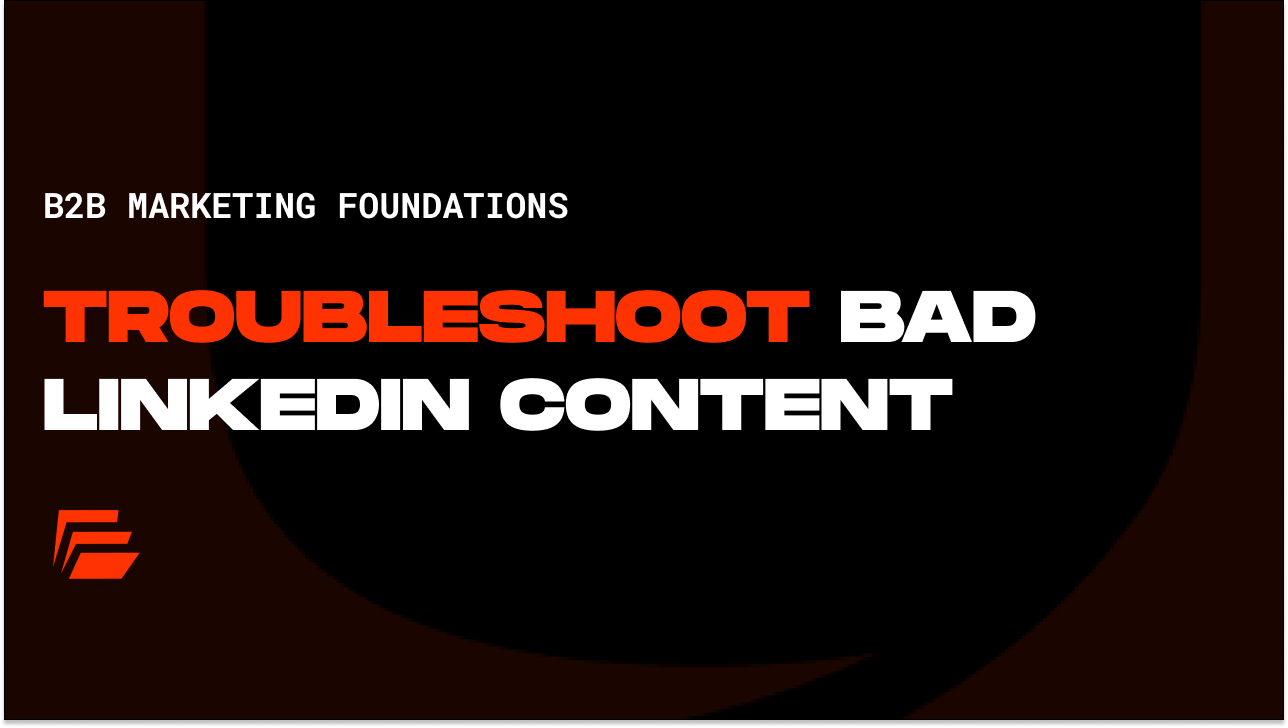- Social Files by Tommy Clark
- Posts
- Troubleshooting bad founder-led LinkedIn content
Troubleshooting bad founder-led LinkedIn content
3 simple tactics for improving post performance and unlocking more distribution

Hey!
Welcome to Social Files—your no-BS guide to generating demand for your B2B product using social & content.
Hope you had a great weekend. Back in Austin now after some travel. Spent the weekend catching up on both sleep and reading.
Current read: Of War and Ruin by Ryan Cahill. This is the third novel in The Bound and the Broken series. I’m fully hooked on this series now. I’d recommend it if you're interested in fantasy at all. Books two and three are massive steps up from the first one. be warned, they are long (book three is 1400 pages 😆).
Now, before I spiral into a tangent on books and writing, let’s get to the content marketing stuff.
Today, I want to walk you through how to fix bad content. If you’ve been posting for some time on LinkedIn, and your content is performing “just OK,” these three tactics will help shake you out of that slump. Promise.
Shall we?
🔎 DEEP DIVE
Troubleshooting bad founder-led LinkedIn content
3 simple tactics for improving post performance and unlocking more distribution

Whenever a founder comes to me complaining about poor-performing LinkedIn content, the root cause is quite simple to diagnose.
There are 3 common culprits for mediocre content I've observed over the past 5 years of producing founder-led content.
(Quick credibility blurb: Have written/edited 1000+ content pieces. Generated tens of millions of impressions. Helped 50+ founders launch on LinkedIn. Etc etc. Have seen a lot of good and bad on this platform.)
(1) Hedging. You're scared. Nervous that your take is going to ruffle some feathers. So you sanitize the hook and turn the body into HR corporate speak. Nobody gets mad at you...but nobody cares.
Case in point: I posted this take on how AI is coming for junior content writers. It’s my honest opinion. No hedging. Racked up 300+ likes and 70K impressions on a simple text-only post.
Further reading: Check out this essay for my advice on how to ‘turn up the dial’ in your content.
(2) Crap Hooks. This is often a symptom of the first error, but not always. Regardless, your hook (first 1-3 lines of each post) is the most important part of each post. Fumble this, and the reader keeps scrolling. I find that founders unwilling to "play the game" and use LinkedIn hook best practices tastefully often struggle.
Further reading: Here is a breakdown of Adam Robinson’s hooks (one of the best to do it on LinkedIn).
(3) BOFU addiction. Every post is a product shill. Every post is a feature demo. "Buy my stuff! Buy my stuff!" you shout into the void. But nobody listens, because nobody cares about your product (at first). Focus more on becoming the go-to resource for your ICP than on constantly pitch-slapping.
Further reading: I wrote an in-depth guide on how to construct a LinkedIn content funnel, here.
So, tactical next steps, when you write your next post:
Write like you speak. No more corpo-slop language!
Put 50% of your effort into the hook. Feels overkill. But trust me.
Try writing a post with a savable framework or tactic your ICP finds valuable
Check out the resources I linked for more in-depth walkthroughs on each. Wanted to keep this read short and sweet.
“Tommy, is there anything else I can do to make my content better?”
Sure. There are other areas you could improve your LinkedIn content. But, from what I’ve observed while producing 150+ posts per week for our clients at Compound, these are the highest-leverage actions you can take.
Address these three errors, and I'd be shocked if you didn't see your LinkedIn performance trend up over the next 30 days or so.
🗃 FILE CABINET
Here’s my favorite marketing and business content I bookmarked this week.
Brutally Honest Advice About LinkedIn Growth in 19 Mins by Tommy Clark 🎥
If your LinkedIn posts get under 1000 impressions… do this by Tommy Clark 🎥
Daniel Ek, Spotify by David Senra 🎥
Check these out.
BEFORE YOU GO…
As always, thanks for allowing me into your email inbox every week.
More from Social Files:
Talk soon,
Tommy Clark